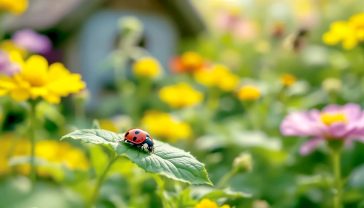The UK Guide to Sunflowers: From Seed to Spectacle
Everything a British gardener needs to know about sunflowers. From giant varieties to dwarf types for pots, learn how to grow these sunny icons with our ultimate guide.

This post may contain affiliate links. If you make a purchase through these links, we may earn a commission at no additional cost to you.
Imagine a flower that’s part-giant, part-sundial, and part-bird feeder. A flower so cheerful it can’t help but make you smile, even on a classic drizzly British afternoon. That’s a sunflower for you. They’re the giants of the garden, often towering over fences and sheds, their golden heads famously turning to follow the sun across the sky.
But there’s so much more to these sunny giants than just their good looks. They’ve travelled across the globe, played a part in history, fed civilizations, and inspired some of the world’s most famous artists. Here in Britain, they’ve become a beloved symbol of summer, a favourite for school growing competitions, and a vital source of food for our garden birds when winter comes knocking.
So, whether you’re a seasoned gardener with an allotment, a parent looking for a fun project with the kids, or just someone who’s curious about this incredible plant, you’ve come to the right place. We’re going to dig deep into the world of sunflowers—from their surprising origins and the science behind their sun-tracking moves to how you can grow a skyscraper of a sunflower in your own back garden. Let’s get started.
The Heart of the Matter: What Exactly Is a Sunflower?
It sounds like a simple question, but the answer is rather clever. A sunflower isn’t just one single flower. Not at all. That enormous head you see is actually a collection of hundreds, sometimes thousands, of tiny individual flowers all packed together. It’s a classic case of teamwork making the dream work.
Think of it like a block of flats. The big, bright yellow petals around the outside are called ray florets. They’re the show-offs, the estate agents’ signs designed to attract the bees and other pollinators. They can’t produce seeds themselves; their only job is to look fabulous and say, “Oi, over here!”
In the centre, you have the disc florets. This is where the real magic happens. Each one of these little guys is a proper, functioning flower that will turn into a seed once it’s been pollinated. They open up in a beautiful spiral pattern, starting from the outside and working their way in. If you look closely at a sunflower head, you can often see this pattern, known as a Fibonacci spiral, the same mathematical pattern you find in pinecones, seashells, and even galaxies. Nature’s a bit of a maths whizz, isn’t it?
The Sunflower Family Tree
Sunflowers belong to a massive plant family called Asteraceae, which is one of the largest in the plant kingdom. This family includes lots of other familiar faces you might find in a British garden or park, like daisies, dahlias, chrysanthemums, and even dandelions. The family’s signature move is this ‘composite’ flower head made of many smaller florets.
The proper name for the common sunflower we all know and love is Helianthus annuus. Helianthus comes from two Greek words: helios, meaning “sun,” and anthos, meaning “flower.” And annuus tells us it’s an annual, meaning it completes its entire life cycle—from a tiny seed to a towering plant and back to seed again—all within one year. So, you have to plant new ones every spring if you want a repeat performance.
A Journey Through Time: The Surprising History of the Sunflower
You might think of sunflowers as belonging to the rolling fields of France or Italy, thanks to Vincent van Gogh. But their story starts thousands of miles away and thousands of years ago, in North America.
Ancient American Origins
Long before they ever reached Europe, sunflowers were being cultivated by Native American tribes as far back as 3000 BCE. They were one of the first crops to be properly farmed in the region, even before maize (corn) and beans. For these early communities, the sunflower was a super-plant. They didn’t just grow it for its beauty; it was a vital source of food, medicine, and dye.
They ground the seeds into flour to make bread and cakes, squeezed them to get oil for cooking, and used different parts of the plant to create yellow and purple dyes for their clothes and bodies. They even used the stalks for building. It was the ultimate multi-purpose crop.
The Great European Adventure
So how did this all-American hero end up in our gardens in the UK? Well, we have the Spanish explorers to thank for that. Around the year 1500, they brought sunflower seeds back to Europe from their travels in the Americas. At first, Europeans were mostly interested in the sunflower as an exotic, ornamental plant. It was a novelty, something to show off in the grand botanical gardens of the rich and powerful.
For a couple of centuries, that’s pretty much all it was. But then, in the 18th century, something changed. People in Russia started to realise the sunflower’s true potential, and it was all down to a rather surprising reason: the Russian Orthodox Church. The Church had a rule that during Lent, its followers couldn’t consume oil from a long list of foods. But the sunflower wasn’t on the list!
Suddenly, everyone in Russia wanted sunflower oil. It became a huge commercial crop, and Russian farmers became masters of cultivating it, breeding new varieties with bigger heads and more oil-rich seeds. In fact, many of the varieties we grow today have their roots in this Russian sunflower boom.
Back to America and Over to Britain
In a funny twist of fate, it was Russian immigrants who reintroduced these super-productive sunflower varieties back to North America in the 19th century, where they kicked off a massive commercial industry.
Here in Britain, sunflowers remained mostly a garden favourite rather than a major farm crop. The Victorians, with their love for grand and dramatic plants, adored them. They became a staple of the cottage garden, standing proudly at the back of herbaceous borders. And, of course, they became the star of every village fete’s “tallest sunflower” competition—a tradition that’s still going strong today.
While we do grow sunflowers commercially in the UK, particularly in the south and east of England, our climate means we’re not quite on the same scale as countries like Ukraine and Russia. For us, the sunflower remains, first and foremost, a beloved garden icon.
How Sunflowers Work: The Science Behind the Spectacle
Sunflowers are more than just pretty faces. They are incredibly well-engineered plants, with a few clever tricks up their stalks.
The Famous Head-Turning Trick: Heliotropism
One of the most famous things about sunflowers is that they follow the sun. This behaviour is called heliotropism, and it’s a bit of a myth, or at least a half-truth.
Young sunflowers are the ones that really do it. They have a special group of cells at the base of the flower bud that controls their movement. During the day, the young sunflower’s head will track the sun’s path from east to west. This helps it soak up as much sunlight as possible for photosynthesis, the process plants use to turn light into energy. It’s like having your own personal solar panel that adjusts itself for maximum efficiency.
But how does it get back to the east overnight, ready for the sunrise? It’s all down to an internal body clock, much like our own. As evening approaches, the stem on the west side grows slightly faster, pushing the head back towards the east, ready to greet the morning sun.
However, once a sunflower gets older and its head becomes heavy with seeds, it stops all this moving about. An adult sunflower generally settles down and just faces east. Scientists believe this is for a couple of reasons. Firstly, by facing the morning sun, the flower head warms up quickly. A warm flower is much more attractive to pollinators like bees, who are more active when they’re warm. An east-facing head can attract up to five times more pollinators than one facing west! Secondly, facing away from the hot afternoon sun might protect the pollen and seeds from getting damaged.
So, the next time someone tells you sunflowers follow the sun, you can tell them they’re only half right!
Built to Last: The Anatomy of a Sunflower
Let’s take a look at the different parts of a sunflower and what they all do.
- The Roots: A sunflower has a main taproot that can grow surprisingly deep into the ground—sometimes over a metre! This helps to anchor the tall plant and stop it from blowing over in a gust of wind. It also has a network of smaller roots that spread out to suck up water and nutrients from the soil.
- The Stalk: The stalk, or stem, is the sunflower’s skyscraper. It can range from just a foot tall in dwarf varieties to over 12 feet in the giant types. It’s thick and fibrous, designed to be strong enough to hold up the heavy head. Inside, it’s like a plumbing system, with tubes that carry water from the roots up to the leaves and flowers.
- The Leaves: The leaves are the plant’s solar panels and lungs. They are typically large, heart-shaped, and rough to the touch. They’re packed with chlorophyll, the green pigment that captures sunlight for photosynthesis. They also have tiny pores, called stomata, which the plant uses to ‘breathe’ in carbon dioxide.
- The Head (Capitulum): As we’ve discussed, this is the main event. A complex structure made of hundreds of smaller florets, all working together to attract pollinators and produce the next generation of seeds.
- The Seeds: Once pollinated, each disc floret develops a single seed. The seed has a hard outer shell, or hull, and inside is the kernel, which is rich in oil and protein.
A Sunflower for Every Spot: Choosing a Variety
You might have a picture in your head of what a sunflower looks like: very tall, with a single yellow head. But the world of sunflowers is surprisingly diverse. There are hundreds of varieties out there, in all sorts of shapes, sizes, and even colours.
Choosing the right one depends on what you want it for. Are you trying to win the village fete? Do you want something to brighten up a pot on the patio? Or are you looking for some beautiful cut flowers for a vase?
For the Record-Breakers: The Giant Varieties
These are the classic sunflowers, the ones that can grow as tall as a house. If you’re after height, these are the ones for you.
- ‘Russian Giant’: This is a very popular, old-fashioned variety. It’s a reliable grower and can easily reach 10-12 feet (around 3-3.5 metres) with a huge head packed with seeds. It’s great for feeding the birds.
- ‘American Giant’: As the name suggests, this one is a true monster. With the right care, it can soar to 15 feet (over 4.5 metres) or even more. It needs a sunny, sheltered spot and plenty of support to stop it from toppling over.
- ‘Titan’: Another giant that lives up to its name, producing enormous flower heads that can be up to two feet across!
For the Small Spaces: The Dwarf Varieties
Not everyone has room for a 12-foot giant. Luckily, there are plenty of smaller varieties that are perfect for pots, containers, or the front of a garden border.
- ‘Teddy Bear’: This is a lovely, fluffy-looking sunflower. It only grows to about 2 feet (60cm) tall and has unusual, double-flowered heads that look like a big, fuzzy pom-pom. It’s a real favourite with children.
- ‘Big Smile’: A cheerful little variety that grows to just 1-2 feet (30-60cm). It produces classic-looking yellow flowers and is very quick to bloom, making it great for impatient gardeners!
- ‘Music Box’: This is a branching variety, which means it produces lots of smaller flowers on one plant, rather than just one big one. The flowers come in a lovely mix of colours, from pale yellow to deep red.
For the Style-Conscious: The Colourful and Unusual Varieties
If you think sunflowers are always yellow, think again. Plant breeders have created some stunning varieties in a whole spectrum of colours.
- ‘Velvet Queen’: A truly dramatic sunflower. It has rich, deep red petals that look almost like velvet. It grows to about 5-6 feet (1.5-1.8 metres) and makes a fantastic statement at the back of a border.
- ‘Earthwalker’: This variety produces flowers in beautiful, earthy tones of orange, bronze, and mahogany brown. It’s a branching type, so you get lots of flowers for cutting.
- ‘Italian White’: For something a bit more subtle, this elegant sunflower has creamy, pale lemon-yellow petals with a dark chocolate-brown centre. It looks wonderful in a vase.
Your Step-by-Step Guide to Growing Sunflowers in the UK
Growing sunflowers is one of the most rewarding things you can do in the garden. It’s easy enough for a complete beginner, and the results can be truly spectacular. Here’s how to do it.
Step 1: Getting the Timing Right
In the UK, the best time to sow sunflower seeds is from late April to May. You can sow them directly into the ground where you want them to grow, or you can start them off indoors in pots to give them a head start, especially if you live in a colder part of the country. Starting them indoors protects the young seedlings from slugs and snails, which absolutely love to munch on them.
Step 2: Sowing Your Seeds
Indoors:
- Fill small pots (about 9cm) with some multi-purpose compost.
- Push one seed into each pot, about 1.5cm deep.
- Water them gently and place them on a sunny windowsill or in a greenhouse.
- They should pop up in about a week or two. Keep the compost moist but not waterlogged.
Outdoors:
- Choose a sunny spot. Sunflowers need at least 6-8 hours of direct sun a day to thrive.
- Prepare the soil by clearing any weeds and digging in some well-rotted compost or manure. Sunflowers are hungry plants!
- Sow the seeds about 1.5cm deep and about 45cm apart for the giant varieties (a bit closer for the smaller ones).
- Water the area well.
Step 3: Planting Out Your Indoor Seedlings
Once your indoor-grown seedlings have a few pairs of leaves and all risk of frost has passed (usually late May or early June), it’s time to plant them out in the garden.
- Harden them off first. This means getting them used to the outdoor conditions gradually. Put them outside during the day for a week or so, bringing them in at night.
- Plant them in their final positions, at the same depth they were in their pots.
- Water them in well.
Step 4: Caring for Your Growing Giants
- Watering: Sunflowers are thirsty, especially as they get bigger and during dry spells. Give them a good soak regularly, aiming the water at the base of the plant.
- Feeding: To get the best results, especially with the giant varieties, you’ll need to feed them. A liquid feed, like a tomato fertiliser, every couple of weeks will work wonders.
- Support: Tall sunflowers act like sails in the wind. They will almost certainly need staking to stop them from snapping. Push a sturdy bamboo cane or wooden stake into the ground near the stem and loosely tie the stem to it with soft garden twine. You’ll need to add more ties as the plant grows taller.
- Pest Control: Slugs and snails are the number one enemy of young sunflower seedlings. Use your preferred method of control, whether that’s slug pellets, beer traps, or going out at night with a torch!
Step 5: Harvesting the Rewards
By late summer or early autumn, your sunflower head will start to droop, and the back of it will turn from green to a yellowish-brown. This is a sign that the seeds are ripening.
For the Birds: If you want to leave the seeds as a treat for your garden birds, simply leave the head on the plant. Finches, tits, and sparrows will love you for it. They’ll cling to the head and peck out the seeds. It’s a natural bird feeder!
For Yourself: If you want to harvest the seeds for roasting and eating, wait until most of the little yellow disc florets have shrivelled up.
- Cut the head off, leaving a good length of stem attached.
- Cover the head with a paper bag or some netting to stop the birds from getting them first and to catch any seeds that fall out.
- Hang it up somewhere warm and dry for a few weeks until the seeds are completely dry.
- To get the seeds out, just rub your hand over the head, and they should fall out easily.
More Than Just a Pretty Face: The Many Uses of Sunflowers
We’ve talked a lot about growing sunflowers in the garden, but their impact goes far beyond our back fences. They are a hugely important global crop.
A Kitchen Staple: Sunflower Oil and Seeds
- Sunflower Oil: This is the most significant commercial use of sunflowers. The oil is pressed from the seeds and is used all over the world for cooking. There are different types of sunflower oil. Some are high in polyunsaturated fats, good for margarines and dressings, while others are high in monounsaturated fats, making them better for frying. It’s a versatile, everyday cooking oil found in almost every British kitchen.
- Sunflower Seeds: The seeds themselves are a popular and healthy snack. They’re packed with nutrients like Vitamin E, magnesium, and healthy fats. You can buy them shelled or in their shells, raw or roasted. They’re great sprinkled on salads, baked into bread, or just eaten by the handful.
- Sunflower Butter: For people with nut allergies, sunflower seed butter is a brilliant alternative to peanut butter. It has a similar texture and a delicious, nutty flavour.
A Farmer’s Friend: Animal Feed and Soil Improvement
After the oil has been pressed from the seeds, the leftover meal is a protein-rich cake that is used as a high-quality feed for livestock like cattle and chickens.
Sunflowers can also be good for the soil. Their deep taproots can help to break up compacted soil, and some varieties are used as a “green manure”—a crop that is grown and then dug back into the soil to improve its structure and fertility.
In the Home and Beyond
The uses don’t stop there. The strong, fibrous stalks can be processed to make paper, and the petals can be used to make natural dyes. In recent years, there’s even been research into using sunflowers to help clean up contaminated land. They are what’s known as hyperaccumulators, meaning they can absorb heavy metals and other toxins from the soil, storing them in their stems and leaves. It’s a slow process, but it’s a fascinating example of how plants can help us heal the environment.
Sunflowers in Culture: A Symbol of Sunshine and Hope
Sunflowers have captured the human imagination for centuries. They pop up in art, literature, and folklore all over the world, usually as a symbol of happiness, loyalty, and adoration because of the way they turn to the sun.
Van Gogh’s Masterpieces
You can’t talk about sunflowers and art without mentioning Vincent van Gogh. The Dutch painter was obsessed with them. He painted a whole series of sunflower pictures while he was living in the south of France in the late 1880s. For him, the sunflower represented gratitude and the vibrant, life-giving power of the sun. His paintings, with their thick, swirling brushstrokes and brilliant yellow colours, are some of the most famous and beloved works of art in the world. One of them is proudly on display in the National Gallery in London.
A Modern Symbol
In more recent times, the sunflower has taken on a new, powerful meaning. It is the national flower of Ukraine, one of the world’s largest producers of sunflowers and their oil. Since the conflict began in 2022, the sunflower has become a global symbol of resistance, unity, and hope for peace. People around the world have worn sunflowers, planted them, and shared images of them to show their solidarity with the Ukrainian people. It’s a poignant reminder of how a simple flower can carry a powerful message.
The Future of the Sunflower
The story of the sunflower is far from over. Scientists and plant breeders are constantly working to create new varieties that are more resistant to disease, more tolerant of drought (which is becoming increasingly important with climate change), and that produce seeds with even healthier types of oil.
As we look for more sustainable ways to live, the sunflower, with its multitude of uses, is likely to become even more important. From providing healthy food and renewable resources to helping clean our soil, this bright, beautiful flower has a very bright future indeed.
So, next time you see a sunflower, whether it’s a lone giant peeking over a garden wall or a whole field of them turning their faces to the sun, take a moment to appreciate it. It’s not just a plant; it’s a piece of history, a feat of natural engineering, a global resource, and a symbol of hope. And it’s something you can easily grow yourself, bringing a little bit of that sunshine right into your own back garden. Why not give it a go?
Further Reading
For those keen to dig even deeper, here are some highly respected British resources:
- Royal Horticultural Society (RHS) – Sunflower Growing Guide: The RHS is the UK’s leading gardening charity, and their advice is second to none. https://www.rhs.org.uk/plants/helianthus/growing-guide
- Kew Gardens – Helianthus annuus (Common Sunflower): Explore the science and botany behind the sunflower from one of the world’s most famous botanical gardens. https://powo.science.kew.org/taxon/urn:lsid:ipni.org:names:331627-2
- The RSPB – Top tips for growing sunflowers: The RSPB offers practical, family-friendly advice for getting started. https://www.rspb.org.uk/helping-nature/what-you-can-do/activities/how-to-grow-sunflowers






